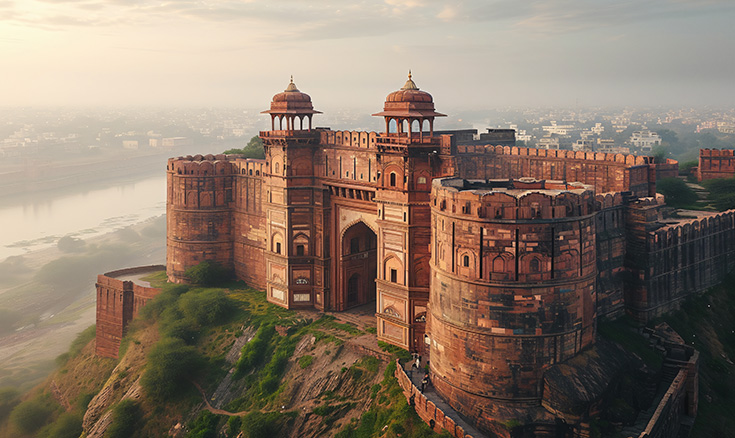Delhi, the capital of India, is a treasure of historical forts. They each tell a part of the story of the city’s great Mughal past. The forts in Delhi that should definitely be on your tour are the UNESCO World Heritage Certified Red Fort – considered one of the finest examples of Mughal architecture, and Lal Kot built by Prithviraj Chauhan. Tughlaqabad Fort is a demonstration of military prowess, while Siri Fort, built by Alauddin Khilji was the city’s touch-point in defending against Mongol attacks.
Feroz Shah Kotla Fort embraces Mughal architecture and compelling legends, and Salimgarh Fort adds another piece to the city’s historical tapestry because of its central point. You would be remiss to not mention Zafar Mahal, the last significant Mughal building constructed in India, and the grand Red Fort complex with the diar-i-Khas and Khas Mahal as legacy to the imperial past of Delhi.
And while it may be true, the Adilabad and Neemrana Fort-Palace visits may be less compelling, these will give history-minded explorers a somewhat precious break. All of these forts are easily identifiable through the metro systems. For instance, Chandni Chowk metro station is immediately outside the Red Fort, and the Fort is truly a national treasure! The forts are key widgets in the historic legacy of Delhi!
Key Takeaways
Red Fort: This UNESCO World Heritage Site is a defining monument of imperial Mughal architecture and, somehow, a panorama of India’s cultural heritage. Built by Shah Jahan, the fort exhibits a variety of Islamic, Persian, and Hindu designs, reflecting some part of the rich evolution of India.
Purana Qila: Among Delhi’s oldest forts, Purana Qila lets one sneak into the very ancient past of the city with its historical architecture.
Lal Kot: Established in 1050 A.D., Lal Kot is actually the oldest surviving fort of Delhi and thus played an important part in the early history of the city.
The forts are not merely monuments; they are also essential in keeping alive the pulsating memory that is Delhi.
Red Fort: The Jewel of Mughal Architecture
A Jewel of Mughal Architecture: Red Fort
Red Fort was built on the orders of Emperor Shah Jahan in 1639, and the fort is an example of Mughal grandeur with huge red sandstone walls surrounding dazzling architecture that incorporates Islamic, Persian, Timurid, and Hindu elements. The fort became a UNESCO World Heritage Site in 2007 and houses some key structures, such as:
Diwan-i-Khas: Decorated with exquisite embellishments.
Khas Mahal: An example of opulent Mughal design.
Rang Mahal: A source of Mughal luxury.
Indian War Memorial Museum: In memory of Indian martyrs.
The fort is also significant historically- every year, on August 15, the Prime Minister of India hoists the National flag here; this remarkable tradition began in 1947. Neemrana Fort Palace also exemplifies the Mughal heritage and is spread over 255 acres, which gives a faint impression of the magnificence of this time.
The Red Fort is, therefore, not only an architectural wonder but also a strong symbol of the Indian freedom struggle and a repository of its cultural integrity.
Also Read, Top 10 Must Try food in Delhi
Puruna Qila: The Oldest Surviving Fort
Purana Qila, otherwise known as the Old Fort, is arguably one of the most ancient surviving forts in Delhi, and it symbolizes the vast history that it has. This fort, built by Sher Shah Suri and later used by Mughal Emperor Humayun, witnessed over 2500 years of history, and some believe it might even find a connection with the legendary city of Indraprastha as per the Mahabharata.
Among the few things one can visit in Purana Qila, Sher Mandal, an 8-sided two-storeyed structure which used to be part of the library and observatory by Humayun, Qila-i-Kuhna Mosque, which is of Indo-Islamic architecture graced with elaborated ornamentation. But in terms of defense, the walls of the fort, at an elevation of 18 meters, were impregnable during the times of which it shows that this fort has a great history to play in Delhi.
Hooded with Pragati Maidan, it is easily accessible and the most appropriate location for those who wish to indulge in revelry with the ancient past of cities. The museum here displays a collection of objects, very well maintained lawns provide utmost peacefulness out of the stressful city. Purana Qila is certainly somewhere to check out for the history buff and perhaps even for someone just trying to visit some of the historic places in Delhi.
Tughlakabad Fort
This Tughlaqabad Fort has been built with great defense works in Indian Military History by Ghiyas-ud-din Tughlaq in 1321. Ruined, but still, its huge size and impressiveness make one feel small before it. The monumental walls of the fort, more than 6.5 km in length, were made to withstand invasions, making it one of the most strategic forts in Delhi.
The fort includes granaries, water tanks, and hideouts. It is an example of the Tughlaq dynasty’s architectural prowess. Though it is mostly in ruins, Tughlaqabad Fort still stands as a proud symbol of a dynasty’s strength. The legend of the curse-said to have been imposed by a Sufi saint-is part of the attraction and makes it a more mysterious place.
Only 13 of the original 52 gates remain in the fort’s structure, giving a haunting and yet beautiful glimpse into Delhi’s past. Its legend, besides the architectural grandeur of the Tughlaq dynasty, makes it a must-see for historians. Situated slightly off the beaten track, it’s ideal for those hoping to wander into offbeat historical spaces in Delhi.
Siri Fort: Alauddin Khilji’s Legacy
From 1297-to 1307, Siri Fort was built by Alauddin Khilji, and stands as a monument of foresight and military strategy. This unit was built against the Mongol invasion for the defense of Delhi, which for medieval history has played a crucial part in the defense of Delhi. The word ‘Siri, ‘according to some, is derived from a gruesome tradition of embedding heads severed from the Mongol warriors into the walls of the fort, as a chilling warning.
Inside this fort was the Palace of a Thousand Pillars, which represented every inch of that time’s architectural genius. It now houses the Siri Fort Auditorium-a modern venue for cultural events and performances-entrancingly laced with the ancient past and present.
Even in its ruined form, the fort stands a prized historical monument of a bygone heritage that casts a shadow over Delhi’s glory days as a fortress. This is sure to be heaven for historians and those looking to imbibe Delhi’s cultural agglomeration as well.
Feroz Shah Kotla Fort: Haunted Historical Site
The 14th-century Feroz Shah Kotla Fort in the heart of Delhi is an abode, steeped in history and intrigue. One of its most splendid characteristics is the ancient Topra Ashokan Pillar, weighing 23 tons and dating from 3rd century BC-an interloper from Haryana, which lends an extra dimension of historical interest to the fort. It too has a mosque, baoli, and beautiful gardens, all of which are unique elements of Mughal architecture.
What makes Feroz Shah Kotla Fort that much more special is its folklore surrounding the jinns. People have flocked to the fort over the years in the hope of calling upon the blessings of these supernatural beings, which have added a bit of theater to an already historically rich site.
It remains undoubtedly one of Delhi’s forts, reputedly haunted-must-see tourist spots, filled with history, architectural beauty, and mystique. Feroz Shah Kotla equally promises an interesting rendezvous for a historian as well as someone intrigued by the supernatural, combining the cultural depth of Delhi with an air of mystery.
Also Read, Top 10 Things to do in Delhi
Salimgarh Fort: Connecting History
This imposing fort holds a significant place in the Delhi layered history, for it was constructed in 1546 by Islam Shah Suri. Once a mighty fortress, it later converted into a prison of political prisoners during all those days of the freedom struggle, thus giving it a highly charged emotional and historical resonance.
Among its striking features is this bridge that connects the fort to the Red Fort, as if a symbolic line between the Suri and Mughal eras. The fort occupies an even more scenic position from where to glimpse the Yamuna, rendering it historically and visually impressive.
Salimgarh is one of those forts, with the amount of fascination it gives within the stones just bordering the concrete lines. It is a must-visit if you’re touring forts in Delhi.
Adilabad Fort: The Lesser-Known Gem
One of the least-known historical jewels is the Adilabad Fort, which happens to be laboriously tucked away near the more famous Tughlaqabad Fort built by Sultan Muhammad Bin Tughlaq. The fort provides a quiet yet powerful look at the architectural style of the Tughlaq dynasty, with its sloping walls, enormous ramparts, and serene surroundings.
Though the fort is in ruins, the layout and the existing structures convey how the royal citadel once stood, built for kings but now open to the curious traveler. Because of no entrance fees, fewer crowds, and a feeling of quiet historical past, it makes a perfect stop for those inclined toward exploring the underrated forts in Delhi.
Zafar Mahal: The Last Mughal Emblem
The last monumental structure of the Mughal Empire is Zafar Mahal, built in the 19th century by Akbar Shah II and enhanced by Bahadur Shah Zafar. Once a summer retreat for the royal family, with its sandstone, marble and Bengali dome in Mughal elegance-it is now deteriorating and storming, yet beautiful.
Despite being a protected monument, this fort is very much neglected, an injurious contrast to its former glory. It is yet another memorable symbol of a dying dynasty, not far removed from the last moments of the last glorious Bahadur Shah Zafar.
If you are a Mughal history buff, this site should not be missed, to grasp the emotive architectural end of an era
Qila Rai Pithora: The Ancient Fortness
Thus built by the legendary Prithviraj Chauhan, Qila Rai Pithora is the first fortified city of Delhi. The fort stretched for around 6.5 kilometers and boasted seven gates, having strong walls that served as a major hub of defense.
The rubble of it is found at various sites across Delhi, Saket, Qutub Complex, Vasant Kunj, and Kshishnagargh, so you feel like you’re walking through a hidden chapter of history in the present neighborhoods; easy to access through Malviya Nagar Metro. possibly the most historically significant forts of all in Delhi.
Lal Kot: Foundation of Delhi
The Lal Kot was erected by King Anangpal Tomar in the year 1050 AD, making it the oldest living fort in Delhi. This fort has accredited Delhi with its strategic and political importance. Later on, the improved structures erected and fortified were created into the early fortified capital of Delhi at Qila Rai Pithora.
Near the complex of the Qutub Minar stand the ruins of Lal Kot, talking faint human sounds whispering from 1000 years ago. Though it is dwarfed by much larger forts, the legacy that Lal Kot leaves behind cannot be matched by any. The real placemaking and the beginning of Delhi’s architecture and military heritage can be seen.
Also Read, Haunted Places in Delhi: Real Ghost Stories & Spine-Chilling Destinations
Summary
Delhi’s forts tell the layered history of the city with authority in their own right. Each fort from the token Red Fort, denoting India’s Independence and Mughal architectural genius, to the Lal Kot, the oldest standing fort of Delhi, tells its own story about the past of Delhi.
The must-see Purana Qila, Tughlaqabad Fort, and Feroz Shah Kotla Fort expose Delhi’s strategic, cultural, and mystical heritage to the world. Siri Fort and Zafar Mahal contribute their share to the architecture of its royalty and warfare. Lesser-known forts like Adilabad Fort or Salimgarh Fort have something to say about the less-explored aspect of the city’s past, calmly.
On the other side of Delhi, the Agra Fort, a UNESCO World Heritage Site, stands as a testimony to the magnificence of the Mughal empire while Humayun’s Tomb further embodies the artistic and historic wealth of this region.
Nearby, Meena Bazaar adds a cultural flavor of artefacts and street food that turns your trip into more than strictly history; it becomes a full-fledged Delhi experience.
These forts are not mere stone monuments, they are the living spirit of the heritage of Delhi.
Frequently Asked Questions
Why is the Red Fort significant in Indian history?
The Red Fort is significant in Indian history as a masterpiece of Mughal architecture and a symbol of India’s heritage, serving as the site for Independence Day celebrations since 1947. Its status as a UNESCO World Heritage Site further underscores its cultural and historical importance.
What is the historical importance of Purana Qila?
Purana Qila holds historical importance as one of Delhi’s oldest surviving forts, constructed by Sher Shah Suri and utilized by Mughal Emperor Humayun. Its significant structures, such as the Sher Mandal and Qila-I-Kuhna Mosque, reflect the architectural advancements of their time.
What makes Tughlaqabad Fort unique?
Tughlaqabad Fort is unique due to its formidable design and the intriguing legend of a curse that resulted in its abandonment, showcasing the strategic prowess of the Tughlaq dynasty through its impressive walls and defensive structures.
Are there any haunted forts in Delhi?
Indeed, Feroz Shah Kotla Fort in Delhi is known for its haunting legends involving Jinns, making it a popular destination for those eager to experience its mystical atmosphere alongside its historical significance.
What is the significance of Lal Kot in Delhi’s history?
Lal Kot, constructed by King Anangpal in 1050 AD, is significant as the oldest surviving fort in Delhi, establishing the city’s strategic importance and serving as a citadel for the Tomar kingdom. Its historical value is integral to understanding Delhi’s rich heritage.




